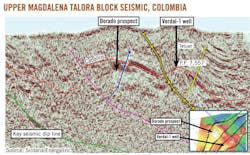A group led by Petrodorado Energy Ltd., Toronto, plans to drill a new wellbore to evaluate "a younger and exceptionally thick sand-prone sequence" that has never previously been reported in Colombia's Upper Magdalena basin.
Despite formation damage incurred in the Dorados-1X wellbore, the underlying conclusion is very encouraging, said Sintana Energy Inc., Plano, Tex., which has a 30% participating interest in three blocks in the basin including the 58,570-acre Talora block (OGJ Online, Oct. 17, 2012).
The partners have concluded that a sidetrack or twin well is needed to further evaluate the Dorados structure, a large thrust anticline in which the Dorados-1X well data now reveal this new thick sandstone reservoir with significant hydrocarbon potential.
Seismic mapping yields four-way and three-way structural closure against the main thrust fault on 2,900 acres to possibly more than 8,000 acres with estimated net reservoir thickness based on limited data in the range of 200 ft and possibly much thicker.
Petrodorado originally planned to drill Dorados-1X to 9,500 ft with primary objectives in the Cretaceous Caballos and Tetuan (Albian/Aptian) formations. While drilling in the Cretaceous Cenomanian section above these objectives, the well encountered a younger and exceptionally thick sand-prone sequence never before reported in the basin.
This sand-prone section, currently named the "Dorados sands," was encountered from about 5,160 ft measured depth to below 7,000 ft, or around 1,850 gross ft thick. While drilling, the section at 5,160-6,035 ft yielded excellent wet gas and oil shows as measured by both gas chromatography and mass spectrometry.
Economic basement was reached much higher than the prognosis at 7,282 ft MD without seeing the Tetuan or Caballos formations. As such, the partnership halted drilling last Sept. 29 to log and production-test the "Dorados sands."
Due to deteriorating hole conditions, tool sticking, and seven lost circulation events, it was operationally impossible to run an adequate logging program. With limited data, however, it was noted that the targeted reservoir section coincides with the highest log resistivities (through casing logs), including zones with fair to good porosities of around 15%.
All these indicators, log resistivities, oil shows, hydrocarbon components (C1 through C9), hydrocarbon ratios, helium and other trace element relationships, are consistent with a thick hydrocarbon column, Sintana Energy noted. In addition, all the indicators terminate abruptly, still within the sand-prone section, at 6,030-50 ft, forming compelling evidence of a basal water contact with a hydrocarbon column above.
In mid-November a program to flow test as many as six sandstone intervals was initiated with a completion and testing rig. Due to formation damage that occurred during drilling, only a limited amount of additional reservoir data were obtained.
The test results confirm that the sand section is a low-pressure reservoir system and that oil has been emulsified. Geochemical lab analysis from production tests proved that this emulsion contains viable 20° gravity crude oil. This provides incontrovertible evidence regarding the severity of the mud invasion and a valid reason as to why certain sandstone intervals with good porosities did not flow during testing.
It is important to note, Sintana Energy said, that these low-pressure reservoirs are common in this part of the basin, including 126 million bbl Guando field 40 km southeast of the Dorados-1X well.
Partners in the Talora block with Sintana Energy, formerly Drift Lake Resources Inc., are operator Petrodorado with 65% interest and Trayectoria Oil & Gas, Bogota, 5%. The block is in steep terrain 60 km west of Bogota and near oil and gas pipelines.
The Talora area has been explored since 1921, but it was only 3 years ago that Petrodorado for the first time targeted the main thrust anticlines located near the center of the block, Sintana Energy said.
It was through drilling the Verdal-1 well in 2010 that the stratigraphy and thickness of the units in the area became clear and that the thrust anticlines had abundant seal section over the main reservoir, protecting the basal Cretaceous reservoirs from being breached to outcrop or leaking to the surface.
"The Verdal-1 well also revealed two new valuable pieces of information: (1) the greater depth of the yet undrilled basal Cretaceous Caballos reservoir unit and most significantly, (2) that the Cretaceous units on top of the Caballos formation are unexpectedly hydrocarbon-charged to the degree that it was not possible to properly control the drilling of the well as it was designed and drilling was abandoned hundreds of feet above the main Caballos reservoir target," Sintana Energy said.
The Caballos reservoir and remains a prime exploration target in the block.



